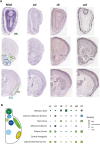Olfactory deficits in aging and Alzheimer's-spotlight on inhibitory interneurons
- PMID: 39737436
- PMCID: PMC11683112
- DOI: 10.3389/fnins.2024.1503069
Olfactory deficits in aging and Alzheimer's-spotlight on inhibitory interneurons
Abstract
Cognitive function in healthy aging and neurodegenerative diseases like Alzheimer's disease (AD) correlates to olfactory performance. Aging and disease progression both show marked olfactory deficits in humans and rodents. As a clear understanding of what causes olfactory deficits is still missing, research on this topic is paramount to diagnostics and early intervention therapy. A recent development of this research is focusing on GABAergic interneurons. Both aging and AD show a change in excitation/inhibition balance, indicating reduced inhibitory network functions. In the olfactory system, inhibition has an especially prominent role in processing information, as the olfactory bulb (OB), the first relay station of olfactory information in the brain, contains an unusually high number of inhibitory interneurons. This review summarizes the current knowledge on inhibitory interneurons at the level of the OB and the primary olfactory cortices to gain an overview of how these neurons might influence olfactory behavior. We also compare changes in interneuron composition in different olfactory brain areas between healthy aging and AD as the most common neurodegenerative disease. We find that pathophysiological changes in olfactory areas mirror findings from hippocampal and cortical regions that describe a marked cell loss for GABAergic interneurons in AD but not aging. Rather than differences in brain areas, differences in vulnerability were shown for different interneuron populations through all olfactory regions, with somatostatin-positive cells most strongly affected.
Keywords: Alzheimer’s disease; aging; inhibition; interneurons; olfaction.
Copyright © 2024 Elhabbari, Sireci, Rothermel and Brunert.
Conflict of interest statement
The authors declare that the research was conducted in the absence of any commercial or financial relationships that could be construed as a potential conflict of interest. The author(s) declared that they were an editorial board member of Frontiers, at the time of submission. This had no impact on the peer review process and the final decision.
Figures


Similar articles
-
Interneurons and beta-amyloid in the olfactory bulb, anterior olfactory nucleus and olfactory tubercle in APPxPS1 transgenic mice model of Alzheimer's disease.Anat Rec (Hoboken). 2013 Sep;296(9):1413-23. doi: 10.1002/ar.22750. Epub 2013 Jul 31. Anat Rec (Hoboken). 2013. PMID: 23904197
-
Neurogenesis, Neurodegeneration, Interneuron Vulnerability, and Amyloid-β in the Olfactory Bulb of APP/PS1 Mouse Model of Alzheimer's Disease.Front Neurosci. 2016 May 30;10:227. doi: 10.3389/fnins.2016.00227. eCollection 2016. Front Neurosci. 2016. PMID: 27303258 Free PMC article.
-
Activation of Granule Cell Interneurons by Two Divergent Local Circuit Pathways in the Rat Olfactory Bulb.J Neurosci. 2020 Dec 9;40(50):9701-9714. doi: 10.1523/JNEUROSCI.0989-20.2020. Epub 2020 Nov 24. J Neurosci. 2020. PMID: 33234611 Free PMC article.
-
Interneurons in the human olfactory system in Alzheimer's disease.Exp Neurol. 2016 Feb;276:13-21. doi: 10.1016/j.expneurol.2015.11.009. Epub 2015 Nov 23. Exp Neurol. 2016. PMID: 26616239 Review.
-
Somatostatin, Olfaction, and Neurodegeneration.Front Neurosci. 2020 Feb 19;14:96. doi: 10.3389/fnins.2020.00096. eCollection 2020. Front Neurosci. 2020. PMID: 32140092 Free PMC article. Review.
References
-
- Ahnaou A., Rodriguez-Manrique D., Embrechts S., Biermans R., Manyakov N. V., Youssef S. A., et al. . (2020). Aging alters olfactory bulb network oscillations and connectivity: relevance for aging-related neurodegeneration studies. Neural Plast. 2020, 1703969–1703917. doi: 10.1155/2020/1703969, PMID: - DOI - PMC - PubMed
-
- Allen Institute for Brain Science . (2004). Allen Mouse Brain Atlas ISH Dataset. Available at: https://mouse.brain-map.org
Publication types
LinkOut - more resources
Full Text Sources
Research Materials
Miscellaneous

